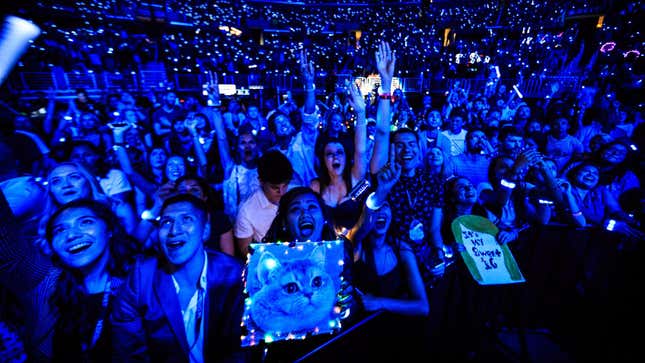
Buzzkills everywhere agree: Fun as they are, attending a loud concert can damage your hearing. Plenty of venues are obnoxiously loud, and you could experience symptoms of hearing loss within just five minutes of exposure the cacophony.
But if you’re someone who frequents live music gigs, your wireless earbuds can help you protect your delicate eardrums.
What causes hearing loss?
According to the CDC, hearing loss can occur either from a single deafening sound or through repeated exposure to loud sounds. Sound is measured in decibels (dB), and you may start to experience symptoms of hearing loss if you frequently encounter sounds over 70 dB, which is about as loud as a washing machine in operation.
Decibels measure loudness, and the intensity of a sound increases exponentially with small, incremental increases in dB levels. According to the CDC, a sound measured at 20 dB is 10 times more intense than one at 10 dB. The next time you see dB levels compared in a chart, be aware the impact of each additional decibel is significant, and that after a certain point, your risk for hearing loss increases exponentially.
For example, CDC data states that more than two hours of exposure to the sounds made by a gas-powered lawnmower (measured at 80-85 dB) put you at a risk for hearing loss. However, hearing loss is likely within less than two minutes of someone shouting into your ear (110 dB). That’s why it’s best not just to consider how loud a sound or environment is, but how much time it will actually take to potentially damage your hearing—it’s a much more useful, real-world way to gauge your risk.
How loud are concerts?
According to the CDC, loudness levels at entertainment venues like rock concerts, bars, and nightclubs average between 105 to 110 dB. At this decibel level, you can experience hearing loss within five minutes of exposure. Even when you are standing far away from the speakers at these venues, the noise is still loud enough to damage your hearing.
If you have a smart device that monitors sound levels (like the Apple Watch), you can monitor your exposure yourself. You can also use apps like Sound Meter on Android, or NIOSH on iPhone.
What you can do to prevent hearing loss at concerts
The best way to prevent hearing loss is to avoid going to loud venues altogether, but that’s not practical advice for live music lovers. If you don’t want to outright loud venues, you have a few options to lower your risk of hearing loss.
If your primary goal is blocking the most sound possible, wearing earplugs is the most effective solution for most people—according to a Creighton University study, well-fitted earbuds can block 15 to 30 dB. You can even buy earplugs made specifically for concerts, engineered to lower your dB exposure while preserving the details of the music. Though these options won’t lower the overall decibel level as much as the best protective earplugs, they are probably a more practical choice for people who want to go to a concert to really hear the music—if you’re just going to wind up taking your earplugs out anyway because they muffle the sound too much, they won’t do you any good at all.
A practical alternative: Wireless earbuds with ANC
Before you buy a special brand of concert earplugs, know that you might already own a high-tech alternative: Your wireless earbuds. Apple’s second-gen AirPods Pro, for example, have both an Active Noise Canceling mode (ANC) and an “Adaptive Transparency” mode that reduces any sound over 85 dB while preserving its overall quality. In the latter case, the AirPods pump in the music from a concert but automatically cap the loudness once it reaches that threshold, theoretically lessening your chances of hearing damage over the course of a two-hour show.
In tests published by The New York Times’ Wirecutter, wearing AirPods Pro with ANC engaged was shown to reduce decibel levels by 23 dB. Adaptive Transparency, on the other hand, reduced noise levels by just 10 dB. The latter wouldn’t bring you below that 85 dB threshold, but it would offer you some level of protection while preserving the sound quality of live music. (Even wearing the Pros without any additional settings enabled cut the venue’s loudness by 8 dB.)
In these tests, Adaptive Transparency mode didn’t cut the loudness enough to be considered CDC-“safe” for any longer than 45 minutes—but that sure beats not wearing anything at all, and you’d still be able to hear all of the music with little to no muffling if that’s what it takes to get you to protect your hearing.
Many other wireless earbuds have a similar hear-through mode that lets some sounds in, while reducing loud environmental noises. Not every pair of earbuds does it well, and if you’re particularly concerned about your hearing health while attending concerts but you still want to hear the music clearly, use a pair of headphones that supports active noise cancellation. If you find everything is still too loud for you when using a feature like Adaptive Transparency mode , you can always enable noise cancellation—but just know that the former will always offer less protection.
Cheaper wireless earbuds may ship with passive noise isolation, which means that some sounds are muffled because there’s a good seal between the headphone and your ear. This is not nearly as effective as active noise cancellation, but again, that’s better than no noise isolation whatsoever.
"sound" - Google News
April 28, 2023
https://ift.tt/ZN52wTB
Can Wireless Earbuds Protect Your Hearing at a Concert? - Lifehacker
"sound" - Google News
https://ift.tt/X3V8oZO
Shoes Man Tutorial
Pos News Update
Meme Update
Korean Entertainment News
Japan News Update

No comments:
Post a Comment